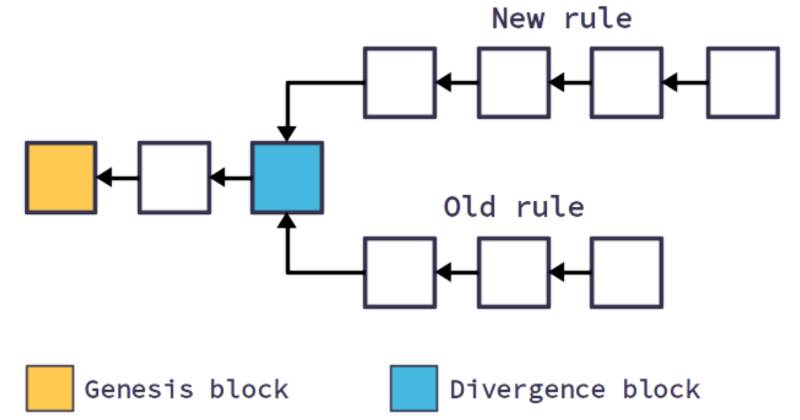1. Introduction & Overview
In blockchain ecosystems, the term “fork” describes a situation where the blockchain network diverges into two possible paths forward. These forks can occur due to protocol changes, community disagreements, or software updates. They are crucial events in the lifecycle of any cryptocurrency and often shape the ecosystem’s future.
Forks are broadly categorized into:
- Hard Forks: Permanent splits where nodes running the old rules are no longer compatible with the new chain.
- Soft Forks: Backward-compatible changes where updated nodes can still communicate with old ones.
2. What is a Fork?

Definition
A fork is a modification in the blockchain’s underlying protocol that results in the blockchain splitting into two versions or maintaining compatibility depending on the type.
History & Background
- 2013–2014: Bitcoin experienced its first major forks, leading to debates around block size and transaction throughput.
- 2016: The DAO hack on Ethereum triggered the Ethereum Hard Fork, resulting in Ethereum (ETH) and Ethereum Classic (ETC).
- 2017: The Bitcoin community split over block size, leading to Bitcoin (BTC) and Bitcoin Cash (BCH).
Relevance
Forks are relevant because they:
- Enable innovation by upgrading network protocols.
- Reflect governance decisions in decentralized systems.
- Can create new digital assets (in hard forks).
- Impact security, scalability, and interoperability.
3. Core Concepts & Terminology
| Term | Definition |
|---|---|
| Consensus Rules | Protocol agreements that determine valid blocks and transactions. |
| Backward Compatibility | Ability of new protocol rules to still validate old transactions. |
| Node | A computer running blockchain software that enforces rules. |
| Chain Split | Event where the blockchain splits into two independent histories. |
| Replay Attack | Attack where transactions valid on one chain are maliciously replayed on another after a fork. |
Lifecycle Fit:
Forks appear in the evolutionary stage of cryptoblockcoins, typically after launch, when scalability, security, or governance debates push communities to update consensus rules.
4. Architecture & How It Works
Components Involved
- Consensus Layer: Defines transaction validation and block creation rules.
- Execution Layer: Where smart contracts or transaction logic runs.
- Networking Layer: Propagates blocks/transactions between nodes.
- Community & Governance: Human actors proposing or voting on changes.
Internal Workflow
- Proposal → Discussion → Implementation in code → Release → Node adoption → Possible fork.
Architecture Diagram (described)
┌──────────────────────────────┐
│ Blockchain Pre-Fork │
└──────────────────────────────┘
│
┌────────────┴────────────┐
│ │
┌───────────────────┐ ┌───────────────────┐
│ Old Consensus │ │ New Consensus │
│ Rules (Chain A) │ │ Rules (Chain B) │
└───────────────────┘ └───────────────────┘
│ │
└───────── Split ─────────┘
CI/CD & Cloud Integration
- Developers manage fork-ready code in Git branches (feature/fork branches).
- CI/CD pipelines (e.g., Jenkins, GitHub Actions) ensure smooth rollouts.
- Cloud tools (e.g., Kubernetes clusters) allow simulation of fork behavior in testnets.
5. Installation & Getting Started
Prerequisites
- Basic knowledge of blockchain nodes (Bitcoin/Ethereum).
- System requirements: 2+ CPUs, 4 GB RAM, 200 GB disk.
- Installed client software (e.g.,
bitcoind,geth).
Step-by-Step Guide (Ethereum Example)
- Download Client:
sudo add-apt-repository -y ppa:ethereum/ethereum
sudo apt-get update
sudo apt-get install ethereum
2. Sync Node:
geth --syncmode fast --datadir ~/.ethereum
3. Update Protocol Rules (Soft Fork):
- Modify
config.jsonwith new consensus parameters. - Restart client.
4. Hard Fork Simulation (Dev Mode):
geth --dev --networkid 12345 --mine
Here, you can test divergent rules.
6. Real-World Use Cases
- Ethereum (ETH vs. ETC) – Hard fork after DAO hack.
- Bitcoin Cash (BCH) – Hard fork from Bitcoin over block size limits.
- SegWit in Bitcoin – Soft fork that restructured how transaction data was stored.
- Ethereum London Upgrade (EIP-1559) – Soft fork that introduced fee burning.
7. Benefits & Limitations
| Aspect | Hard Forks | Soft Forks |
|---|---|---|
| Pros | – New coin creation- Clear governance decisions- Enables major protocol changes | – Backward compatibility- Less disruptive- Lower community split risk |
| Cons | – Risk of community divide- Replay attacks- Double ecosystem maintenance | – Limited scope- Relies on majority upgrade- Ambiguity if not widely adopted |
8. Best Practices & Recommendations
Security Tips
- Implement replay protection for hard forks.
- Test thoroughly on testnets before mainnet fork.
- Use multi-sig wallets during transition.
Maintenance
- Maintain clear documentation of fork changes.
- Ensure continuous monitoring of both chains.
Compliance & Automation
- Automate deployments with Ansible/Terraform.
- Align forks with regulatory transparency (especially for exchanges).
9. Comparison with Alternatives
| Method | Fork (Hard/Soft) | Sidechains | Layer 2 Solutions |
|---|---|---|---|
| Scope | Consensus change | Independent chain | Off-chain scaling |
| Backward Compat. | Hard: NoSoft: Yes | No | Yes |
| Complexity | Medium–High | High | Medium |
| When to Use | Protocol changes, governance disputes | Specialized use cases | Scalability, lower fees |
10. Conclusion
Forks are the evolutionary DNA of blockchain ecosystems. They represent both opportunities and risks—innovation on one hand, fragmentation on the other.
Future trends include:
- More planned soft forks for upgrades (Ethereum’s Merge, Bitcoin Taproot).
- Community-driven governance tools to prevent hostile splits.
- Hybrid approaches (soft fork leading into hard fork transitions).
For developers and researchers, forks are not just technical adjustments—they are socio-technical events that shape the destiny of cryptoblockcoins.
References & Communities
- Bitcoin Developer Docs
- Ethereum Foundation
- Bitcoin Optech – Soft Fork Discussions
- GitHub Repositories, https://github.com/ethereum/go-ethereum